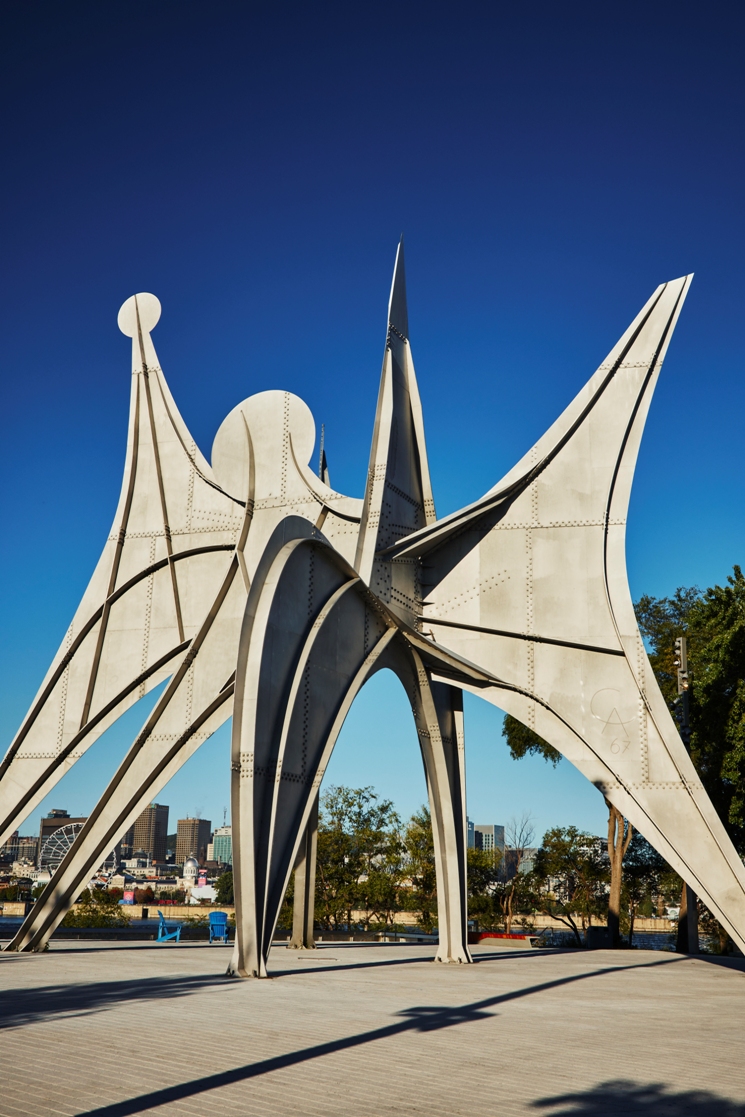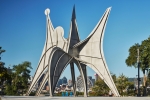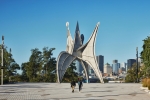Alexander Calder
Trois disques
1967
Presentation of the artwork
Alexander Calder’s sculpture Trois disques is composed of arched legs made of unpolished stainless steel. The overlapping arches stand on six slender posts that culminate with two points and three disks. With its abstract form, the structure – asymmetrical but balanced – creates plays of shadow and light that evoke dance movements. The sculpture evokes human progress and power. Its site – it was moved in 1991 to the belvedere in Parc Jean-Drapeau on Île Sainte-Hélène build to receive it, 300 metres from its original site – allows the public to circulate around the work and view it from different angles, from near and far. Over the years, it has become an important landmark in the Montréal landscape. Although a number of cities have purchased a Calder stabile, the one in Montréal is unique. At a height of 22 metres, it is the second-tallest stabile (after the one in Mexico City, which is 24 metres in height). At the request of the International Nickel Company of Canada, it is not painted, which also makes it the only example of an unpainted monumental stabile. Therefore, Trois disques shows off the raw material, the elements of assembly, and the traces of its fabrication in a frankly industrial aesthetic. In short, human labour and genius can be seen in Calder’s imposing sculpture. Associated events
Commissioned from Alexander Calder by the International Nickel Company of Canada for the eponymous square at the Montréal World Fair held in 1967, the artwork was officially presented to Montréalers when the fair ended. Inspired by the “Man and His World” theme of Expo 67, its monumentality made it one of the distinctive symbols of the event.
© 2024 Calder Foundation / Artists Rights Society (ARS), New York / CARCC, Ottawa
crédit photo: Marc-Olivier Bécotte, 2022
Alexander Calder
Alexander Calder, born in 1898 in Lawnton, Pennsylvania, came from a family of artists: his father, Alexander Stirling Calder, and his grandfather, Alexander Milne Calder, were sculptors, and his mother, Nanette Lederer Calder, was a painter. He trained as an artist at the Art Students League of New York from 1923–25. Considered one of the foremost sculptors of the twentieth century, Calder left his mark in the public space with his “mobiles” and “stabiles.” The latter word, coined by Jean Arp, refers to Calder’s stationary works. In his later years, he made monumental stabiles composed of simple forms anchored to the ground, which are found, among other places, in Berlin, Chicago, Jerusalem, Paris, Mexico City, and Seattle. Alexander Calder died in New York in 1976
Awards and honours
- Presidential Medal of Freedom, United States, 1977
- Bicentennial Medal of New York City, 1975
- United Nations Peace Medal, 1975
- Le Grand Prix National des Arts, France, 1975
- Gold Medal for Sculpture, National Institute of Arts and Letters and American Academy of Arts and Letters, 1971
- Honorary Degree of Doctor of Engineering, Stevens Institute of Technology, 1969
- Officier de la Légion d'Honneur, France, 1968
- Honorary Degree, Doctor of Arts, Harvard University, 1966
- Creative Arts Award, Sculpture, Brandeis University, 1962
- Fine Arts Gold Medal for a Master of Sculpture, American Institute of Architects, 1961
- Gold Medal of Honor, Architectural League of New York, 1960
- First prize in sculpture, Carnegie International, 1958
- Award for Pre-eminence in Art, Philadelphia Art Festival, 1955
- First prize for a foreign sculptor, Venice Biennale, 1952
- First prize in the Museum of Modern Art, New York, competition for Plexiglas sculpture, 1939
Presentation of the artwork
Alexander Calder’s sculpture Trois disques is composed of arched legs made of unpolished stainless steel. The overlapping arches stand on six slender posts that culminate with two points and three disks. With its abstract form, the structure – asymmetrical but balanced – creates plays of shadow and light that evoke dance movements. The sculpture evokes human progress and power. Its site – it was moved in 1991 to the belvedere in Parc Jean-Drapeau on Île Sainte-Hélène build to receive it, 300 metres from its original site – allows the public to circulate around the work and view it from different angles, from near and far. Over the years, it has become an important landmark in the Montréal landscape. Although a number of cities have purchased a Calder stabile, the one in Montréal is unique. At a height of 22 metres, it is the second-tallest stabile (after the one in Mexico City, which is 24 metres in height). At the request of the International Nickel Company of Canada, it is not painted, which also makes it the only example of an unpainted monumental stabile. Therefore, Trois disques shows off the raw material, the elements of assembly, and the traces of its fabrication in a frankly industrial aesthetic. In short, human labour and genius can be seen in Calder’s imposing sculpture. Associated events
Commissioned from Alexander Calder by the International Nickel Company of Canada for the eponymous square at the Montréal World Fair held in 1967, the artwork was officially presented to Montréalers when the fair ended. Inspired by the “Man and His World” theme of Expo 67, its monumentality made it one of the distinctive symbols of the event.
Alexander Calder
Alexander Calder, born in 1898 in Lawnton, Pennsylvania, came from a family of artists: his father, Alexander Stirling Calder, and his grandfather, Alexander Milne Calder, were sculptors, and his mother, Nanette Lederer Calder, was a painter. He trained as an artist at the Art Students League of New York from 1923–25. Considered one of the foremost sculptors of the twentieth century, Calder left his mark in the public space with his “mobiles” and “stabiles.” The latter word, coined by Jean Arp, refers to Calder’s stationary works. In his later years, he made monumental stabiles composed of simple forms anchored to the ground, which are found, among other places, in Berlin, Chicago, Jerusalem, Paris, Mexico City, and Seattle. Alexander Calder died in New York in 1976
Awards and honours
- Presidential Medal of Freedom, United States, 1977
- Bicentennial Medal of New York City, 1975
- United Nations Peace Medal, 1975
- Le Grand Prix National des Arts, France, 1975
- Gold Medal for Sculpture, National Institute of Arts and Letters and American Academy of Arts and Letters, 1971
- Honorary Degree of Doctor of Engineering, Stevens Institute of Technology, 1969
- Officier de la Légion d'Honneur, France, 1968
- Honorary Degree, Doctor of Arts, Harvard University, 1966
- Creative Arts Award, Sculpture, Brandeis University, 1962
- Fine Arts Gold Medal for a Master of Sculpture, American Institute of Architects, 1961
- Gold Medal of Honor, Architectural League of New York, 1960
- First prize in sculpture, Carnegie International, 1958
- Award for Pre-eminence in Art, Philadelphia Art Festival, 1955
- First prize for a foreign sculptor, Venice Biennale, 1952
- First prize in the Museum of Modern Art, New York, competition for Plexiglas sculpture, 1939






